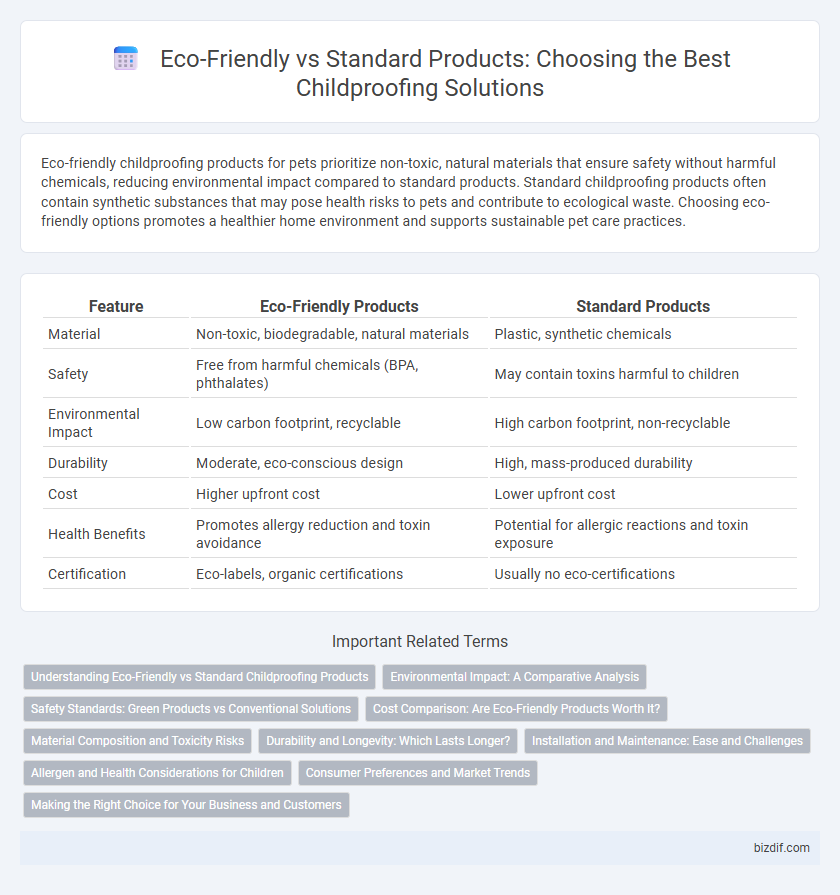Eco-friendly childproofing products for pets prioritize non-toxic, natural materials that ensure safety without harmful chemicals, reducing environmental impact compared to standard products. Standard childproofing products often contain synthetic substances that may pose health risks to pets and contribute to ecological waste. Choosing eco-friendly options promotes a healthier home environment and supports sustainable pet care practices.
Table of Comparison
| Feature | Eco-Friendly Products | Standard Products |
|---|---|---|
| Material | Non-toxic, biodegradable, natural materials | Plastic, synthetic chemicals |
| Safety | Free from harmful chemicals (BPA, phthalates) | May contain toxins harmful to children |
| Environmental Impact | Low carbon footprint, recyclable | High carbon footprint, non-recyclable |
| Durability | Moderate, eco-conscious design | High, mass-produced durability |
| Cost | Higher upfront cost | Lower upfront cost |
| Health Benefits | Promotes allergy reduction and toxin avoidance | Potential for allergic reactions and toxin exposure |
| Certification | Eco-labels, organic certifications | Usually no eco-certifications |
Understanding Eco-Friendly vs Standard Childproofing Products
Eco-friendly childproofing products are made from non-toxic, sustainable materials such as bamboo, organic cotton, and BPA-free plastics, reducing harmful chemical exposure for children and minimizing environmental impact. In contrast, standard products often contain PVC, phthalates, and other potentially hazardous substances that enhance durability but pose health risks and environmental concerns. Selecting eco-friendly options supports safer indoor environments and promotes sustainable consumer choices for families focused on long-term wellbeing.
Environmental Impact: A Comparative Analysis
Eco-friendly childproofing products significantly reduce environmental impact by utilizing biodegradable materials and non-toxic chemicals, minimizing pollution and waste. Standard products often contain harmful plastics and synthetic compounds that persist in landfills and contribute to chemical pollution. Choosing eco-friendly options supports sustainability and decreases the ecological footprint of child safety measures.
Safety Standards: Green Products vs Conventional Solutions
Eco-friendly childproofing products adhere to strict safety standards by using non-toxic, BPA-free materials that reduce exposure to hazardous chemicals, unlike many conventional solutions that may contain harmful substances. These green products often undergo rigorous third-party testing to ensure they meet or exceed industry safety guidelines, providing parents with greater peace of mind. Choosing eco-friendly childproofing options supports healthier indoor environments while maintaining effective protection against common household risks.
Cost Comparison: Are Eco-Friendly Products Worth It?
Eco-friendly childproofing products often have a higher upfront cost compared to standard options, but their durability and non-toxic materials can reduce long-term expenses related to replacements and health risks. Investing in eco-friendly solutions supports a safer environment for children by minimizing exposure to harmful chemicals commonly found in conventional products. The potential savings in healthcare costs and environmental benefits make eco-friendly childproofing products a cost-effective choice over time.
Material Composition and Toxicity Risks
Eco-friendly childproofing products are typically made from natural, non-toxic materials such as organic cotton, BPA-free plastics, and sustainably sourced wood, significantly reducing exposure to harmful chemicals. Standard products often contain synthetic compounds like phthalates, lead, and PVC, which pose potential health risks including respiratory issues and developmental problems in children. Choosing eco-friendly materials minimizes toxicity risks and supports safer environments for child safety installations.
Durability and Longevity: Which Lasts Longer?
Eco-friendly childproofing products often use sustainable materials like bamboo or recycled plastics, enhancing durability without harmful chemicals, whereas standard products may rely on cheaper, less resilient plastics prone to wear and tear. Studies indicate that eco-friendly options maintain structural integrity longer, reducing the need for frequent replacements and minimizing waste. Prioritizing longevity in childproofing solutions supports both safety and environmental responsibility by delivering lasting protection for children.
Installation and Maintenance: Ease and Challenges
Eco-friendly childproofing products typically feature non-toxic materials and simpler designs, making installation straightforward while minimizing exposure to harmful chemicals. Standard products often require more complex installation processes involving screws or adhesives that can damage surfaces and complicate adjustments or removals. Maintenance for eco-friendly options is usually easier due to durable, washable materials, whereas standard products may degrade faster and demand frequent replacements or repairs.
Allergen and Health Considerations for Children
Eco-friendly childproofing products minimize exposure to harmful chemicals and allergens, reducing health risks such as respiratory issues and skin irritations in children. Standard products often contain synthetic materials and toxins like phthalates and BPA, which can trigger allergic reactions and developmental concerns. Choosing non-toxic, hypoallergenic materials ensures a safer environment by promoting cleaner indoor air quality and preventing chronic health problems in sensitive children.
Consumer Preferences and Market Trends
Consumer preferences in childproofing increasingly favor eco-friendly products due to growing health and environmental awareness, driving shifts in market demand. Eco-friendly childproofing solutions, made from sustainable materials and free from harmful chemicals, outperform standard products in safety and appeal among environmentally conscious parents. Market trends indicate a steady rise in sales of green-certified childproofing items, reflecting the industry's response to evolving consumer values and regulatory pressures.
Making the Right Choice for Your Business and Customers
Choosing eco-friendly products for childproofing services enhances safety while reducing environmental impact, appealing to health-conscious families and environmentally aware clients. These products often use non-toxic materials and sustainable manufacturing processes, differentiating your business as responsible and forward-thinking. Standard products may be cost-effective initially but can pose health risks and generate more waste, potentially harming your brand reputation in the long run.
Eco-friendly products vs Standard products Infographic

 bizdif.com
bizdif.com